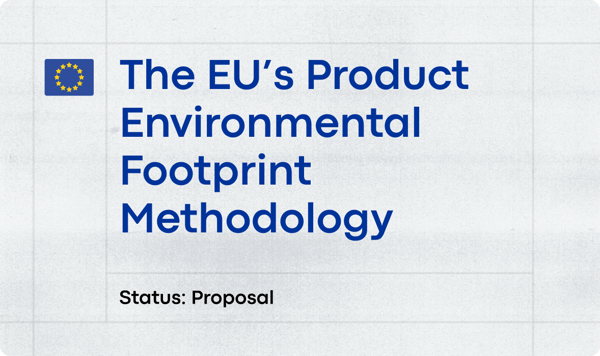The French Eco-score is a part of the Climate and Resilience Law, is also known as “environmental labeling” and has now been officially renamed to and is also known as "Environmental Cost". It’s a methodology for assessing and communicating the environmental impacts of textile products, meant to build on the life cycle assessment and evaluations of 16 environmental indicators like carbon emissions, water consumption, and biodiversity impact.
Jump directly to the December 2024 updates.
🇫🇷 Read this deep dive in French: L’éco-score textile : les points essentielsWhat is the French Climate and Resilience Law?
Passed in 2021, the French Climate and Resilience Law grew out of the French Anti-Waste for Circular Economy Law (AGEC). It touches a broad spectrum of sustainability issues, from transport and travel to housing and land use. For fashion and textile brands, this legislation largely addresses eco-labeling requirements and greenwashing.
If your business operates in the EU, the French Climate and Resilience Law is one of several national sustainability laws that you’ll need to be aware of.
Now, let’s take a deeper look at this impactful legislation.
What Does the Textile Eco-Score Mean for Fashion Brands?
The law will impact fashion and textile brands in two significant ways: labeling and environmental claims. In this article, we will only focus on Eco-score labeling:
At the time of sale, consumers must have access to accurate information about “the environmental impact of the goods and services considered over their entire life cycle." This includes several environmental indicators, such as greenhouse gas emissions, the impact on biodiversity, and the consumption of water and other natural resources.
In 2022, the Union des Industries Textiles (UIT) collaborated with the French Agency for Ecological Transition (Ademe) to release and test a new environmental display method for textiles. The trial period experimented with a variety of methods, including an ABCDE score and a score out of 100. Note that this has now changed to a numerical score – see the bottom of this blog post.
.png?width=2000&height=1254&name=3%20(3).png)
.png?width=2000&height=1522&name=1%20(3).png)
Who Needs to Comply?
The environmental labeling requirements apply to all producers, importers, and distributors who place textile products on the French market. This includes any apparel company, French or foreign, that operates within the French market, regardless of its origin.
The decree does not explicitly mention exemptions for small fashion brands or specific thresholds of company size. It appears that all entities engaged in the sale or distribution of the specified products, whether large corporations or small businesses, are required to comply. However, further decrees or implementation guidelines may specify progressive timelines or exceptions for smaller apparel brands.
This also means that non-French companies are included if they market products in France. Textile importers are explicitly mentioned as responsible for ensuring compliance with the environmental labeling requirements for clothing products they introduce into the French market.
Timeline for Apparel and Footwear Brands
The French Eco-score for textiles becomes mandatory one year after the law's entry into force, which we expect will be in 2026. Currently, calculating and displaying the French Eco-score remains voluntary.
The Eco-score consultation and expected 2025 launch provide an opportunity for fashion brands to prepare now.
Here is a timeline to keep in mind:
.jpg?width=2000&height=1330&name=2%20(2).jpg)
December 2024 Updates
The French Eco-score framework has just taken a significant step forward – and has a new name. On November 28th, the Minister of Ecological Transition launched an official consultation, signaling progress toward its long-awaited implementation. This marks an important moment for fashion and textile brands preparing to navigate upcoming environmental labeling requirements.
After two years of development, this is the final step before validating the regulatory framework for displaying the environmental cost of clothing provided for by the Climate and Resilience Act. It is intended to become mandatory after a period of voluntary experimentation by clothing brands.
Now, with the framework progressing, here are the key updates we have so far:
Eco-score Display
Instead of "Eco-score", the score is now referred to as "Environmental Cost" (Cout environmental) and is displayed as a score in absolute value instead of an ABCDE ranking. For the sake of familiarity, we’ll keep referring to it as Eco-score throughout this article but know that the official name is no longer the same.

The Public Consultation: What’s Included?
France has officially notified the European Commission of its draft Decree & Order relating to the environmental display system for clothing. The standstill period, which lasts three months, is now in effect and will end on May 14, 2025. This consultation focuses on two key regulatory texts defining the parameters of the French Eco-score for textiles.
- Draft Decree: Defines the methodology for calculating environmental impacts and the rules for communication. Fashion brands voluntarily communicating aggregated environmental product scores must adhere to the Eco-score methodology. Scores calculated using other methods must remain consistent with the Eco-score. The decree applies to new and remanufactured clothing textiles sold on the French market.
-
Draft Order: Outlines product categories, calculation methods, and labeling requirements. It specifies the logo and different ways brands must communicate environmental impacts. The Order also establishes exclusion rules, such as for items where more than 20% of their total mass consists of non-textile materials or when materials are not included in the Ecobalyse database without a suitable proxy. Notably, Article 9 introduces the display of the environmental cost per 100g into the signage, adding a new dimension to consumer-facing sustainability information.
With the standstill period now active, the European Commission and other stakeholders can provide feedback before the decree and order come into force.
Methodological Updates
As the Eco-score framework progresses, new details are emerging about how fashion brands can calculate and communicate their scores effectively. Here are the quick facts we know so far:
- Labeling options: Brands can display environmental impacts per mass (e.g., points per kilogram) in addition to the score per product.
- Product Range Definitions: Product-range width will be defined by segment (men, women, children, etc.).
- Repair services: To be considered in Eco-score calculations, repair services must be labeled by Refashion, the French eco-organization for textiles.
- Traceability: Brands must make traceability details visible both on their website homepage and on in-store tags.
- Year-Round Validity: Parameters used in the modeling must remain valid year-round, including during sales periods.
- Trims Modeling: Updates to better model trims and other smaller components are planned for future methodology iterations.
EU-alignment on Eco-score and PEFCR
In recent months, the French methodology has converged towards the European PEF method, however, the major differences mentioned above cause significant variation in the scores obtained between the two methods – which could lead to consumer confusion. That’s why the Eco-score and PEFCR (Product Environmental Footprint Category Rules) are being aligned to converge as a medium-term goal, in order to make compliance easier for brands across France and the EU. It’s important to repeat that the PEFCR for Apparel and Footwear is still in the recommendation phase, meaning it’s not legally binding yet.
The French government plans to notify the European Commission in January 2025, following feedback from the consultation on the French EcoScore. The EU will then review the proposed methodology within 3 months. By April 2025, the PEF A&F (Product Environmental Footprint for Apparel and Footwear) is planned to be finalized. This will allow brands to calculate and communicate both the Eco-score and the PEF Score.
French eco-score vs EU PEFCR
The French Eco-score methodology aims to correct the biases and shortcomings of the European PEFCR framework which does not yet include durability, micro-plastics, biodiversity loss and significantly underestimates the impacts of polyester, favoring fast fashion. It thereby introduces criteria that relate not only to the products but to the commercial practices of the fashion brand that manufactures them.
It takes into account in particular:
- Part of the business practices of fast fashion through the “extrinsic” sustainability coefficient, composed of three parameters: the breadth of the range, the incentive to repair and the display of the traceability of the garment. These criteria do not exhaustively define fast fashion, but they are relevant.
- The specific impacts of polyester and other synthetic fibers through microfiber
- Environmental benefits of organic and/or local materials, through the choice of a high weighting of the ecotoxicity criterion of the LCA, and through updated inventory data for wool.
- Emotional Durability, but not yet physical durability
There are also differences in weightings and granularity between the French and European databases, as well as the addition of 2 additional impact categories ("export outside the EU" and "emission of microfibers").
.png?width=2000&height=1722&name=2%20(2).png)
Which Data Do You Need to Calculate the French Environmental Cost for Textiles?
- the product category;
- the mass/weight of the finished product;
- the nature and percentage of the materials that make up the product, provided that these materials represent at least 2% of the total mass of the product and 5% of the total impact of the modeled product
- the geographical origin of the weaving/knitting stage
- the geographical origin of the finishing or printing stage
- the geographical origin of the manufacturing stage
Optional parameters for which there are default values available:
- the remanufactured or non-remanufactured nature of the product;
- the number of references in the market segment
- the reference price
- the size of the company and the repair services offered
- the apparent display or not of the geographical traceability of the production stages
- the geographical origin of the raw materials
- the geographical origin of the spinning stage
- where applicable, the type of printing applied to the garment
- where applicable, the application of a fabric fading process
- the share of air transport (post confection)
- the list of accessories integrated into the sales unit, in particular buttons, zips, frames
Notes on mass: The mass and composition of each part of the product must be provided (e.g. main fabric 200g 90% cotton / 10% polyester and lining 100g 100% cotton). It is not necessary to provide information for parts representing less than 2% of the product mass or less than 5% of the product impact.
Which Clothing Categories Are Included?
The calculation of the Eco-score relates to a single size, applicable to all other sizes falling within the same segment. The segments considered are as follows:
- Boxers/Briefs
- Socks
- Shirts
- Jeans
- Skirts/Dresses
- Swimwear
- Coats/Jackets
- Trousers/Shorts
- Sweaters
- T-shirts/Polos
Also, lingerie products will be included if they meet the criteria of composition in textile fibres (at least 80% of the total mass of the product). There is still work to be done to be able to model the typical accessories of a bra.
The following textile products are currently excluded:
- Second-hand products.
- Products of which more than 20% of the mass is composed of materials other than textile fibres
- Products for which more than 20% of the mass is composed of materials whose modelling of the contribution to the calculation of the environmental cost does not appear in the methodological notice (i.e. is not present in the list of Ecobalyse materials)
- Products integrating electronic components.
- Products made from Leather and accessories e.g. belts, scrunchies, cases, pouches, bags, totebags)
- Personal protective equipment unless it can be purchased directly by end consumers.
Voluntary Communication
If a brand wishes to communicate the environmental impact of its products, it must:
- Follow the Eco-score Methodology: Ensure compliance by adhering to the official Ecobalyse methodology for calculating scores.
- Provide Level 1 Parameters: Make key data publicly available on their website.
- Declaration portal: Submit the Eco-score and calculations to the declaration portal.
- Logo: Use the official visual.
However, if the fashion brand is already calculating another aggregated environmental score (an aggregated score being one that combines several impact metrics into a single value), such as the PEF score, then:
- The apparel brand also has to share the French Eco-score.
- Ensure the consistency between the two scores.
(If scores are not aggregated (e.g., product carbon footprint, % recycled content), there is no obligation to display the Eco-score)
Declaration Portal Requirements
A centralized portal will require textile brands to upload their scores, calculation parameters, and related data, with bulk import options available. Other required information includes the calculation date and the legal nature of the entity responsible for performing it. When brands calculate their French Eco-score, they will be obliged to share it on this portal.
Why Should Fashion Brands Calculate the Score by Themselves?
Starting one year after the launch of the Eco-score, third parties (e.g. distributors or apps) will be allowed to calculate scores for the clothing brands using publicly available parameters. Third parties rely on default parameters for missing data, which are conservative and result in higher (less favorable) Eco-scores. This happens because third parties lack access to optional, detailed product data, such as specific material choices or production processes, which only brands can provide.
However, scores calculated by brands take priority and override third-party scores (with a maximum delay of one month). Fashion brands can include nuanced details and optional parameters that reflect a more accurate environmental performance of their products, leading to more accurate and favorable scores.
Updates and Revisions
The Eco-score framework allows for updates to ensure accuracy and reflect improved data:
- Quarterly Updates: Brands can update their scores every three months with more precise data or corrections.
- Mandatory Revisions: If the methodology or decree is modified, brands must revise their scores within 12 months to remain compliant.
This structured approach ensures that the Eco-score reflects the most accurate and current information over time.
What’s Next?
The next update (Version 2.7) of the French Eco-score framework will address product range definitions and other refinements. It is scheduled for release shortly, providing more detailed guidance for brands.
We will keep you updated!
Tooling
The French environmental labeling system is made up of several tools for calculating the environmental cost of products and ensuring that the results are comparable. For instance, the ADEME issued general documentation for the environmental impact assessment of clothing products. The government has also published the Ecobalyse platform, a free online calculator for estimating the environmental impact of textile and food products (as these categories of products will be the first concern). The current version of the tool will be upgraded in the coming months to take account of the latest methodological developments.
How Can Carbonfact Help Your Brand?
Product Life Cycle Assessment: Our platform delivers comprehensive life cycle assessments (LCAs) tailored to the most recent Eco-score and EU PEF standards. We automatically calculate the Eco-score for each product, encompassing all 16 environmental indicators required for compliance.
Increased Accuracy over Ecobalyse: Ecobalyse provides simplified LCA calculations with readily available, global-average data, meant to provide only a preliminary environmental score. Carbonfact’s extensive database, built over years of cooperation with 150+ brands and their suppliers, contains an exhaustive amount of primary data and secondary data from a variety of scientifically-validated sources. In addition we have accurate calculations for more processing steps and materials, and we cover more product categories such as footwear.
Data Consolidation and Cleaning: Carbonfact consolidates diverse datasets from any source or format, making data management simple and efficient. Missing or incomplete data? Our AI, trained on extensive primary datasets, fills gaps by automatically estimating details such as component weights, dtex values, and process-level steps.
Hotspot Analysis: Carbonfact identifies emission hotspots in your supply chain, helping you focus on areas with the greatest potential for impact reduction. We provide a targeted list of data points to gather from your suppliers, saving your team weeks of time and ensuring a more complete and precise Eco-score.
Proactive Compliance and Reporting: Our platform tracks methodology updates and ensures your scores remain compliant as regulations evolve. Carbonfact generates ready-to-submit reports for the French declaration portal and other regulatory requirements.
.jpg?width=2000&height=1144&name=2%20(1).jpg)
(French Eco-score Calculated on the Carbonfact's platform)







 Lidia Lüttin
Lidia Lüttin

![[Guide] Carbon accounting for fashion, textile, apparel, and footwear companies](https://www.carbonfact.com/hs-fs/hubfs/CA%20-%20Opt1.png?width=600&name=CA%20-%20Opt1.png)
 Angie Wu
Angie Wu